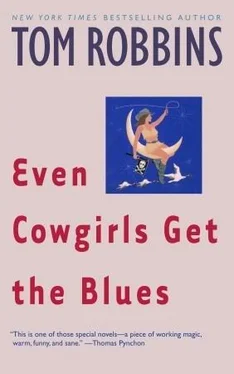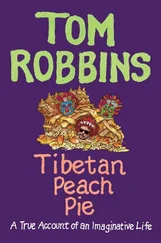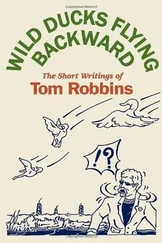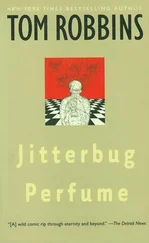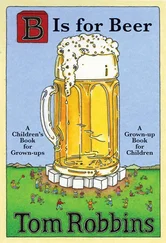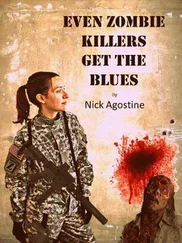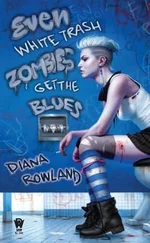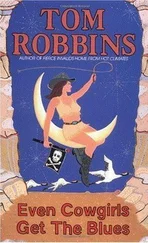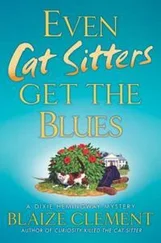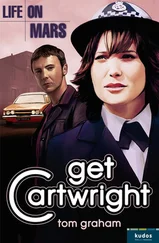Fingers — and thumbs — of rose were drumming gently, like a Juilliard professor at a jazz club, on the table top of early morning America.
First light ventured through the windows of the bunkhouse. Softly, cowgirls turned in their beds. They made sleepy little noises, like the love cries of angel food cakes.
Heather was dreaming about her diabetic mother, who was forever threatening to commit suicide with Hershey bars if Heather didn't come home. Almost inaudibly, Heather whimpered into her pillow. Jody was dreaming she was back in high school, taking a math exam. She remembered that she hadn't studied, and she began to sweat with embarrassment and fear. Mary was dreaming she was ascending to Heaven in a rubber life raft. In the dream, Mary wore flippers on her feet. Mary would wake up puzzled. Elaine was dreaming about the source of her bladder infection. Her nipples were erect. She was smiling. LuAnn was dreaming the dream she dreamed nearly every night, the one in which her boy friend, his dilated pupils as black as Muslim golf balls, approached her with a dripping needle. In real life, she had awakened a few hours after the fix. Two years later, her boy friend still had not come to. LuAnn was on the verge of screaming. Debbie was dreaming she could fly, and Big Red, snoring mightily, dreamed she had found a lot of money lying around on the ground. Linda was dreaming she was in bed with Kym. She woke up and discovered that it was true. She scampered back to her own bunk.
Just in time. The sack of peyote buttons beneath Delores's head was singing her awake, as it did each morning. The forewoman stretched and rubbed her eyes. Soon she would stride down the aisle cracking her whip. No alarm clocks were necessary at the Rubber Rose. Besides, a clock radio would have played nothing but polkas.
From the main house there floated the voodoo smell of perking coffee. Donna, whose turn it was, had already begun breakfast. Up, pardners, up. There were goats to be milked and birds to be. . watched over.
Plap. Plap plap plap . Bare cowgirl feet began to hit the linoleum. Feet with painted nails and feet with blisters, clean-smelling feet and feet fermenting in toe jam, tender feet, flaking feet, feet that had fidgeted indecisively in shoe stores and feet that had fallen in love with the gym floor at the prom, go-go feet, ballet-lessons-on-Saturday-mornings feet, pink feet, yellowish feet, arched feet, flat feet, massaged feet, neglected feet, beach feet, sneak feet, tickled-by-Daddy feet, feet pinched red by too-tight boots, feet that attracted glass shards and splinters and feet that imagined themselves to be clouds. Plap plap . Bare feet kissed the linoleum and pattered girlishly to foot lockers (in which there were no spare feet), to windows (to see what kind of weather was afoot) or out to the shitter (exactly ninety-two feet from the bunkhouse).
Plap. Plap . Listen. There were other plaps to be heard upon that summer's dawn. Plaps sounded in cities and towns where no barefoot cowgirls trod. The author is speaking now of the plap and plap of morning newspapers, rolled and tucked, plapping against porches as newsboys demonstrated their careless aim.
Countless newspapers landed with countless plaps on countless porches, bringing to countless readers the ball scores and comics and horoscopes and, on that particular morning, the first public notification of what many would consider a shocking ecological disaster. Different papers played the story in different ways. Perhaps the headline in the St. Louis Post-Dispatch , succinct as it was, told it best. It read: OUR WHOOPING CRANES ARE MISSING.
78.
SOME FIVE HUNDRED THOUSAND YEARS AGO, the North American continent finally got up enough nerve to kick the last of the glaciers out of its parlor. Ice gone, the North American continent called in the decorators and ordered them to create an environment worthy of some classy new wildlife. “Grass is in,” the decorators announced, and they began to assemble a landscape of vast prairies, inland seas and wet savannas. A primitive pre-Pleistocene swamp bird cast a yellow eye upon the endless acres of marshy vegetation, waving grass and shallow waters and decided it liked the new décor well enough to move in. In fact, this bird liked the new décor so much it let out a whoop. Thus, inspired by its surroundings, it evolved into the whooping crane.
The whooper was classy, all right. It combined great size with majestic beauty and a kind of shy arrogance to produce a total effect that no bird before or since has equaled. The satiny black markings on its dazzlingly white body were economically and perfectly placed; its ruby crown and cheek patches (which were, in fact, red skin bare of all feathers) provided a certain flash without being vulgar; its tapered silhouette and graceful curves were to excite artists and designers not yet born; its powerful voice could spook the spine of a predator from a half-mile away; the aloof pride with which it conducted its daily business invented the word dignity for animal dictionaries. Ranging coast to coast and from the Arctic to central Mexico, the whooping crane was surely El Birdo Supremo in North America during the Golden Age of Grass.
Things change. Even grass goes out of fashion. In the later Pleistocene, trees became a hot item. Forest gradually encroached on the grasslands and the water table subsided. The crane habitat, un-Sanforized, began to undergo a relentless shrinking. The sandhill crane, the whooper's smaller, plainer cousin, made the necessary adjustments, adapting good-naturedly to a less grassy, less watery world. But not our bird. The whooping crane practiced the science of the particular; it enacted the singular as opposed to the general; it embodied the exception rather than the rule. To hell with compromise! It knew what it wanted and that was that. Unlike those integrity-short teemers, including man, the whooper opted for quality instead of quantity, rejected the notion that anything is better than nothing. It would survive on its own terms or not at all. And, indeed, it retreated in numbers as well as range, clinging defiantly to ever-narrowing confines. The whooping crane population had dwindled to fewer than two thousand even before civilization set its hard, polished shoes upon our shores.
Still, two thousand whoopers were two thousand whoopers — enough sheer feather power to stop every show in the nightclub district of birdland — and the crane census might have remained at that approximate figure had not civilization decided to do North America a favor by inviting itself to dinner. Between civilization and whooping cranes there was an immediate and lasting personality conflict. In the luggage of the civilizing process there came farming, shotgun sport, egg collecting, industrialization, urban sprawl, polluting, aviation, oil drilling, military operations, grass fires and the Army Corps of Engineers, those busy little khaki beavers who have set out to turn America's natural waterways into industrial ditches. Added to predators, climate changes and hurricanes, it was a bit too much for the super duper whooper. After 1918, when a Louisiana farmer named Alcie Daigle shot twelve cranes that were feeding on rice fallen from his threshing machine (Alcie Daigle, may sharp beaks scissor your testicles daily in the fried ricefields of Hell!) there were but two flocks of wild whooping cranes left alive in the world. Soon there was only one. By September 1941, this flock, incessantly harassed, was down to fifteen birds. Fifteen, count 'em, fifteen. Extinction music swelled in the background.
Ever since its founding in 1905, the conservationist Audubon Society had taken a special interest in whoopers. It knew an extraordinary bird when it watched one. The Audubon's little old ladies and mild gentlemen in galoshes pecked at the government so tirelessly that finally the politicians, in a weary outburst, decreed, in 1937, that the wintering grounds of the last remaining whooper flock would henceforth be a refuge. Like most prolife gestures on the part of the government, the Aransas National Wildlife Refuge on the Gulf Coast of Texas was not much more than a token. Aransas offered the cranes winter shelter from hunters and egg collectors, to be sure, but the U.S. Air Force was allowed to maintain a bombing range right off shore, and the major oil companies continued to drill and dredge and diddle and daddle all along the edges of the preserve. Also, the flock, though illegal game, had no real protection on their long migratory flights between Aransas and their summer nesting and breeding grounds in the northern Canadian wilderness, and each year several cranes fell to the merry pow-pows of drunken sportsmen. The flock hung on to life by its toenails, although it hung with aplomb.
Читать дальше
